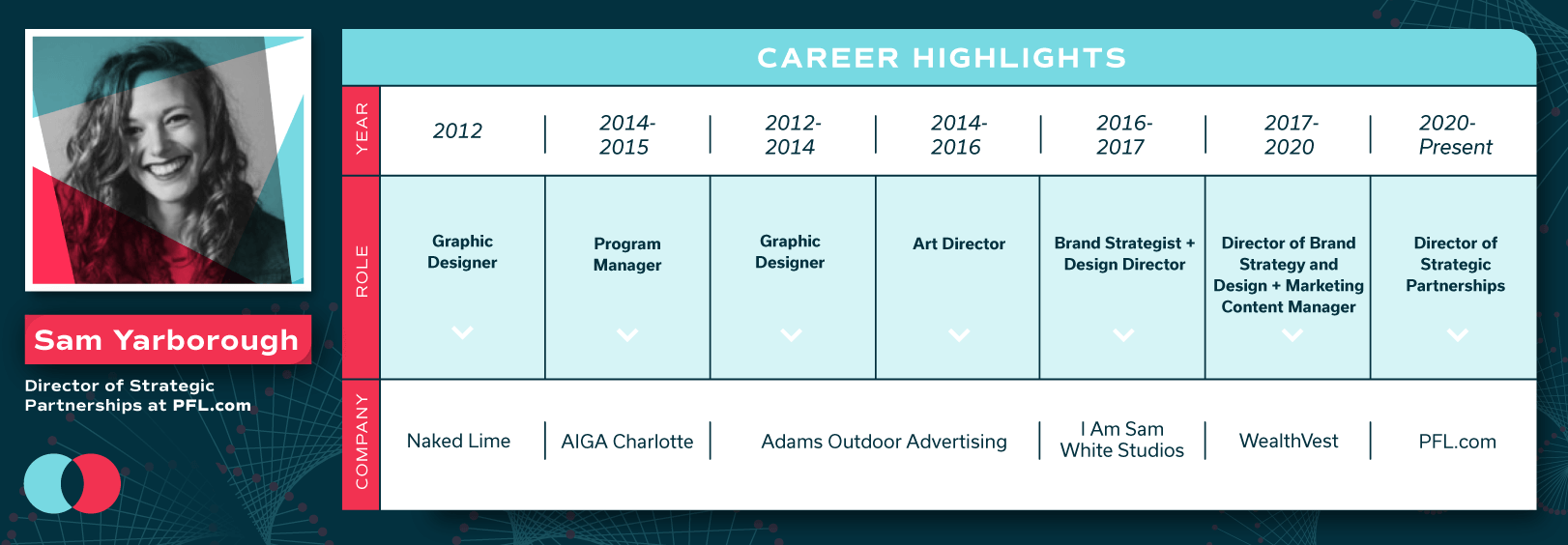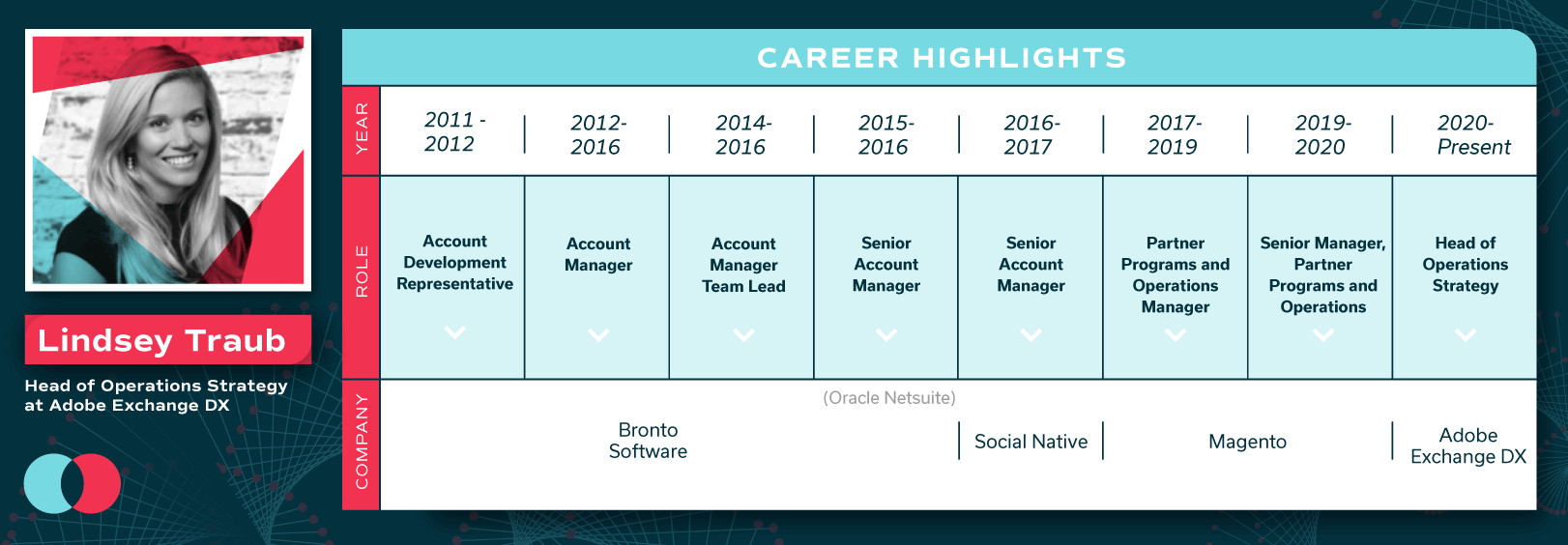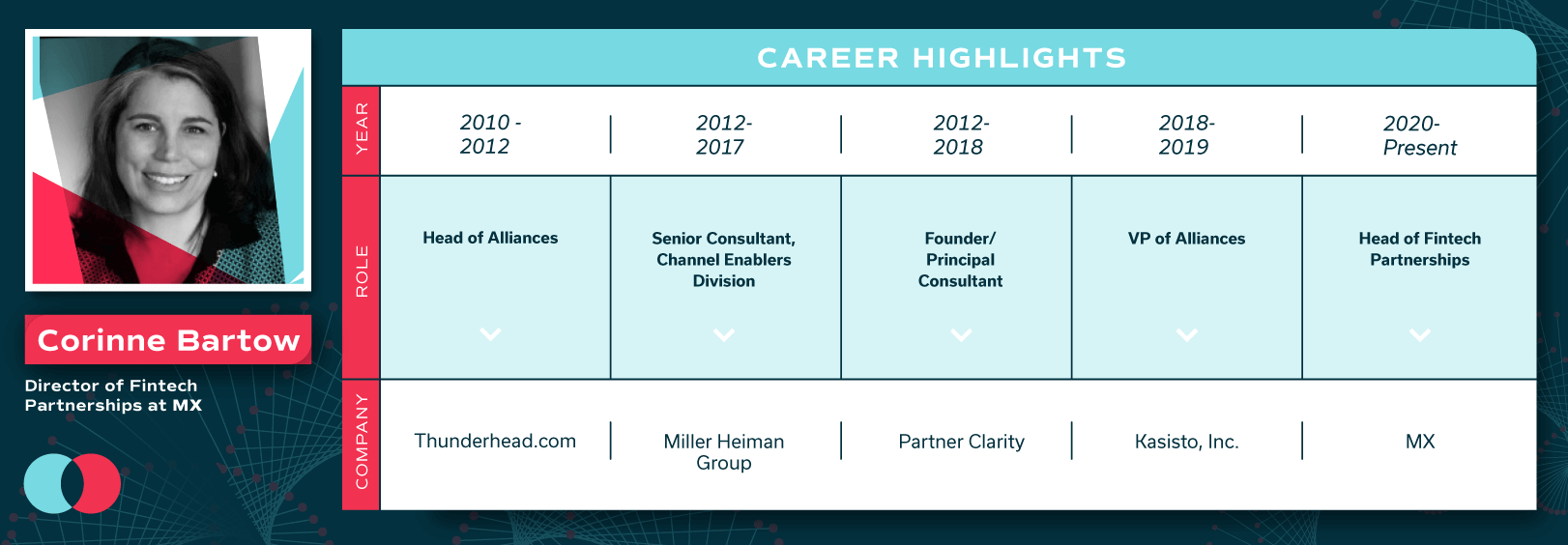We recently launched the 2021 State of the Partner Ecosystem Report and noticed something interesting — of the 173 survey respondents, only 55 were women.
(Get the 2022 State of the Partner Ecosystem Report here.)
This got us thinking: How can more women transition into and advance their careers in partnerships? It’s difficult to walk a path you rarely see, so we’re highlighting the career paths of six partnership leaders and sharing their tips for career development success. So, whether you’re aspiring to step into the shoes of a partnership executive at your company or you’re scrolling through partnership job postings on LinkedIn, know that these women were once in your place.
Jump Around
- Danielle Simon, Director of Channel, Alliances, and Partnerships at CybelAngel
- Lindsey Traub, Head of Operations Strategy at Adobe Exchange DX
- Diane Schmidt, VP of Partner Development at Optimizely
- Corinne Bartow, Director of Fintech Partnerships at MX
- Ashley Hildreth, VP of Business Development & Partnerships at Clyde
- Sam Yarborough, Director of Strategic Partnerships at PFL.com
1. Danielle Simon, Director of Channel, Alliances, and Partnerships at CybelAngel
Life before partnerships: marketing, sales
Top Tip: Ask These Questions Before Joining a Partnerships Org
“I can’t stress the importance enough of picking a company that is internally aligned on partnerships,” says Danielle Simon.
If you’re interviewing for a partnerships role, Simon suggests asking the leadership team and other stakeholders, “What do partnerships mean to you?” or “What does a successful partnership look like?” to understand the team’s current priorities, existing challenges, and the long-term vision. For example, sales might expect net new leads from partnerships while your executive team has a revenue target in mind for partner-sourced deals. While revenue is always the end goal, determine if the focus for driving that revenue is on lead generation or solution building so you know what you’re accountable for.
“It’s important to think about the maturity of the partnership function in a new company and your own pre-existing network in a space,” says Simon. “It will influence how quickly you can build up repeatable revenue and how you define success. If you are building from scratch, you need some runway.”
Simons suggests thinking through these questions during the interview process:
- What’s the background profile of the founders? The investors? Do they have previous experiences with partnerships, and what’s their attitude toward partnerships as a growth strategy?
- Will you be the first channel person? Has there been another channel person? Or has there been a flurry of channel folks cycling out of the company?
- Will you be a lone channel person or will you be working in a team? If in a team, what is the channel team structure and where does it fit in the broader org structure? Who will you report to?
- Is there executive-level representation for partnerships?
- Does the company understand how partners can make money? What are their goals for partnerships?
- Do they run into channel conflict and how do they manage it?
- How much education will you need to do internally (and at what levels of the company) for your coworkers to understand what partnerships are and the value they can drive?
2. Lindsey Traub, Head of Operations Strategy at Adobe Exchange DX
Life before partnerships: customer success and account management
Top Tip: Align Your Team With the Customer Success and Product Teams
Lindsey Traub still wears her former customer success hat to evaluate integration adoption and retention for Adobe Exchange DX, the company’s app marketplace.
“Everything we’re trying to put out into the ecosystem has to be built on customer satisfaction,” says Traub. “There has to be both acquisition and retention.”
Traub says to regularly check in with product and customer success teams. “They’re on the forefront and they can give me feedback that no one else can,” she says. “The best thing I did [for my career] is pull folks aside to ask questions and get close to the product org to understand where we’re going and why,” says Traub.
She suggests asking your customer success, sales, and product teams questions like:
- Which accounts are seeing drops in retention?
- Why do you think retention is slipping in these specific areas?
- What are our customers’ biggest concerns?
- Where are there gaps in our offering?
- What challenges do customers have that the product can’t solve yet?
- What are you and your team frustrated with?
Asking these questions to your internal teams helps you discover gaps in your product’s features and the workflows it supports, which can also inform your integration roadmap with tech partners.
Traub attributes her promotions to Senior Partner Programs and Operations Manager at Magento in 2019 and Head of Operations Strategy for Adobe Exchange DX in 2020 to taking on new responsibilities and to increasing visibility of the partnership team’s successes.
When Adobe acquired Magento in 2018, Traub led her team through the change by:
- Helping her partner marketing team implement new channel marketing software
- Building out CRM reports and dashboards for other internal departments to help them illustrate their successes (She didn’t own those particular reports, but rather, was using her reporting and data analysis skills to help out her fellow coworkers.)
- Taking over the design, creation, and launch of partner banners for the marketplace site each month
- When it was decided to unify Magento, Marketo, and Adobe’s partnership programs, Traub took on the legal workstream and became a conduit between her business unit and the legal team in order to streamline contracting and execution
- Provisioning sandboxes for the Magento platform temporarily
- Communicating partner team successes during regular team meetings and sending updates to executive partnership leaders for extra visibility
3. Diane Schmidt, VP of Partner Development at Optimizely
Life before partnerships: Sales
Top Tips: Don’t Underestimate the Power of Casual Check-Ins and Build Data Analysis Skills to Communicate Your Success
“What’s most satisfying about the channel is that when you’re building and cultivating relationships with partners, it’s years long, ” says Diane Schmidt. “Keep in touch with partners you’ve worked with because if you move to a new role you never know when you might have the opportunity to work together again.”
Schmidt will randomly call partners to see how they’re doing both personally and professionally from a partnership standpoint. “Those conversations are some of the most fruitful ones,” says Schmidt.
One of Schmidt’s casual check-ins led to a joint marketing campaign and resulted in a referral for a new license sale in 2020.
“We have about 150 partners in North America and I try to speak with at least 50 of them every month. It’s important to maintain the pulse of what’s going on with our partners,” says Schmidt.
Additionally, Schmidt says you should learn how to build and maintain reports and dashboards that illustrate your impact on the business — whether it’s the number of tech integrations built or leads generated or partner-sourced/ influenced revenue — and then use that data to evangelize your accomplishments.
Don’t hold back. Own your success.
“Be in a position to tell your management or sales leadership, “Look what I did, or look at what my team accomplished this quarter,” says Schmidt. “Because if you’re not keeping track of yourself, no one else is going to do that for you,” she says.
4. Corinne Bartow, Director of Fintech Partnerships at MX
Life before partnerships: engineering, product management, sales, consulting
Top Tips: Be an Expert in Your Partner’s Business & Document Everything
Corinne Bartow recommends researching, profiling, and segmenting partners by their business models, regions, industries, or company sizes.
“There’s an 80/20 rule, or if you’re lucky, a 60/40 rule, where 20%-40% of your partners will be the ones that are really driving business with you,” says Bartow. “Not every partnership you develop is going to do that, so the better you know their business and understand that fit and how you’re going to market with them, the better you can predict which ones will be successful.”
Bartow says to document everything, including:
- Joint-authored partnership plans that lay out both parties’ goals and objectives
- Partner summaries with intel on a partner’s business model, specialties, industry expertise, customers, products, and services
- Meeting notes from partner check-ins
Documenting everything forces you to be more thoughtful about the mutual goals of the partnership and brings clarity to the tasks and deliverables you need from partners and internal stakeholders. Plus, if one of your reps sees an opportunity to engage your partner in a co-selling motion, your organized documentation offers a baseline of information (and saves you both time!)
5. Ashley Hildreth, VP of Business Development & Partnerships at Clyde
Life before partnerships: graphic design, entrepreneurship, sales
Top Tip: Ask Questions Early On in Your Role to Gain Executive Buy-In
When asked what advice she would give to her younger self, Ashley Hildreth said she would have prepared herself for how cross-functional a role in partnerships truly is.
Conducting discovery across each business unit or department will help you define success, set proper expectations with stakeholders, and strengthen internal alignment so that when it comes time to ask for more resources, the support is there.
Hildreth suggests using these questions early on in your role to define success with your executive team — In turn, you’ll gain clarity on the outcomes you need to drive.
- What is the greater impact of partnerships?
- Are other departments (i.e. marketing, sales ops, people ops, etc.) prepared to offer support to ensure the success of the partner org ?
- How is success measured and communicated?
Are we only considering revenue contribution or are there other KPIs that will be considered? - How can I ensure that you as the leadership team are really excited about what I’m trying to do here?
“You have to ask questions rather than make statements, because I think that encourages [leadership] to think critically about [partnerships] and it gets more buy-in from them on how to best approach [partnerships],” she says.
Hildreth started her career in partnerships as a Manager of Agency and Solution Partnerships for North America for Trustpilot, and a year later, was promoted to Head of Partnerships. Her education-first approach to partnerships — which entailed asking questions about partners’ motivations and goals and helping them understand how the partnership would help their businesses succeed — helped her build excitement among Trustpilot’s partner ecosystem. This resulted in an active, collaborative referral program that surpassed the initial revenue goals set by Hildreth’s team.
6. Sam Yarborough, Director of Strategic Partnerships at PFL.com
Life before partnerships: graphic design, branding, marketing
Top Tip: Know the Maturity of the Partner Program You’re Joining
If you’re exploring a new partnership role, Sam Yarborough says you should think about two things: 1) Are you going to be building a partnership program from nothing or scaling the program’s tools, workflows, and processes? and 2) What’s the maturity of the partnership program you’re joining?
“If you’re looking to build a foundation for a program that can scale, a company that doesn’t have a super mature partnership program might be the best way to go. If you are new to partnerships, seeking out mentors in this situation is key,” says Yarborough.
“Know that you will be forging ahead to build a culture of partnerships internally, a network of partnerships externally, and a foundation for a program that drives value for you and your partners,” she says. “If you’re looking to join a fairly established program, then keep in mind they’re probably looking for ways to operationalize that program, ways to add integrations or GTM strategies and define and deliver on formalized revenue goals.”
Knowing the difference between the two will help you understand what processes you need to establish and the kinds of outcomes you’ll need to achieve to be successful in your role. Ideally, you’ll want to develop the skills to build and scale partnership programs, but it ultimately depends where the company is at in their maturity.
Yarborough’s expertise in graphic design and brand strategy and marketing — the ability to articulate business cases, lead discussions with leadership teams, and pitch ideas in ways that people want to listen — helped her get a Director role at PFL.com, where she’s restructuring the foundation and strategy for their partnership program.
“I love brand strategy because if a company has a good brand, it spans every part of a company. It’s a culture. The executive team has to stand behind it. Sales has to understand it, marketing, customer service… and the same goes for partnerships,” she says.
–









This is a test comment.
This is a longer test comment to see how this looks if the person decides to ramble a bit. So they're rambling and rambling and then they even lorem ipsum.